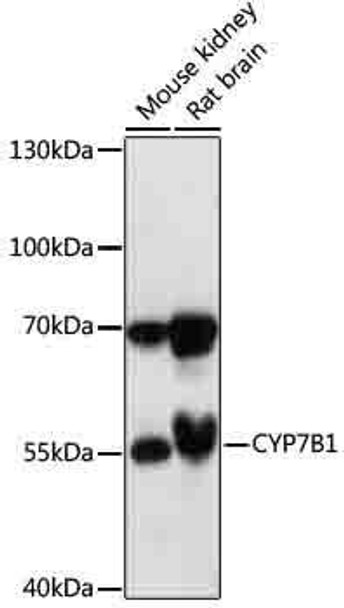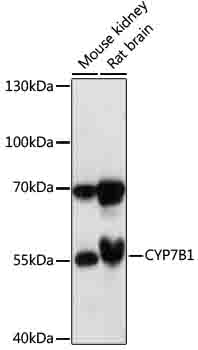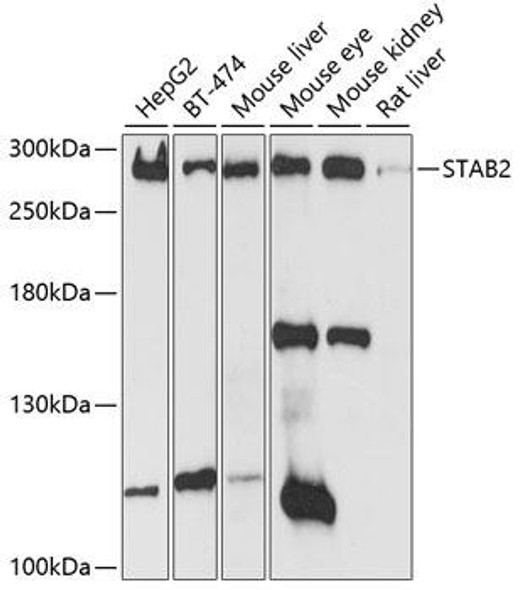Anti-CYP7B1 Antibody (CAB17872)
- SKU:
- CAB17872
- Product type:
- Antibody
- Reactivity:
- Human
- Mouse
- Rat
- Host Species:
- Rabbit
- Isotype:
- IgG
- Antibody Type:
- Polyclonal Antibody
- Research Area:
- Metabolism
Frequently bought together:
Description
| Antibody Name: | Anti-CYP7B1 Antibody |
| Antibody SKU: | CAB17872 |
| Antibody Size: | 20uL, 50uL, 100uL |
| Application: | WB |
| Reactivity: | Human, Mouse, Rat |
| Host Species: | Rabbit |
| Immunogen: | A synthetic peptide corresponding to a sequence within amino acids 200-300 of human CYP7B1 (NP_004811.1). |
| Application: | WB |
| Recommended Dilution: | WB 1:500 - 1:1000 |
| Reactivity: | Human, Mouse, Rat |
| Positive Samples: | mouse kidney, rat brain |
| Immunogen: | A synthetic peptide corresponding to a sequence within amino acids 200-300 of human CYP7B1 (NP_004811.1). |
| Purification Method: | Affinity purification |
| Storage Buffer: | Store at -20°C. Avoid freeze / thaw cycles. Buffer: PBS with 0.02% sodium azide, pH7.3. |
| Isotype: | IgG |
| Sequence: | VIVC DNNK FISE LRDD FLKF DDKF AYLV SNIP IELL GNVK SIRE KIIK CFSS EKLA KMQG WSEV FQSR QDVL EKYY VHED LEIG AHHL GFLW ASVA NTIP T |
| Gene ID: | 9420 |
| Uniprot: | O75881 |
| Cellular Location: | Endoplasmic reticulum membrane, Microsome membrane, Peripheral membrane protein |
| Calculated MW: | 58kDa |
| Observed MW: | 58kDa |
| Synonyms: | CYP7B1, CBAS3, CP7B, SPG5A |
| Background: | This gene encodes a member of the cytochrome P450 superfamily of enzymes. The cytochrome P450 proteins are monooxygenases which catalyze many reactions involved in drug metabolism and synthesis of cholesterol, steroids and other lipids. This endoplasmic reticulum membrane protein catalyzes the first reaction in the cholesterol catabolic pathway of extrahepatic tissues, which converts cholesterol to bile acids. This enzyme likely plays a minor role in total bile acid synthesis, but may also be involved in the development of atherosclerosis, neurosteroid metabolism and sex hormone synthesis. |
| UniProt Protein Function: | CYP7B1: Defects in CYP7B1 are the cause of spastic paraplegia autosomal recessive type 5A (SPG5A). Spastic paraplegia is a neurodegenerative disorder characterized by a slow, gradual, progressive weakness and spasticity of the lower limbs. Rate of progression and the severity of symptoms are quite variable. Initial symptoms may include difficulty with balance, weakness and stiffness in the legs, muscle spasms, and dragging the toes when walking. In some forms of the disorder, bladder symptoms (such as incontinence) may appear, or the weakness and stiffness may spread to other parts of the body. Defects in CYP7B1 are the cause of congenital bile acid synthesis defect type 3 (CBAS3). Clinical features include severe cholestasis, cirrhosis and liver synthetic failure. Hepatic microsomal oxysterol 7-alpha-hydroxylase activity is undetectable. Belongs to the cytochrome P450 family. |
| UniProt Protein Details: | Protein type:EC 1.14.13.100; Oxidoreductase; Endoplasmic reticulum; Lipid Metabolism - primary bile acid biosynthesis Chromosomal Location of Human Ortholog: 8q21.3 Cellular Component: endoplasmic reticulum membrane Molecular Function:oxysterol 7-alpha-hydroxylase activity Biological Process: bile acid biosynthetic process; sterol metabolic process Disease: Bile Acid Synthesis Defect, Congenital, 3; Spastic Paraplegia 5a, Autosomal Recessive |
| NCBI Summary: | This gene encodes a member of the cytochrome P450 superfamily of enzymes. The cytochrome P450 proteins are monooxygenases which catalyze many reactions involved in drug metabolism and synthesis of cholesterol, steroids and other lipids. This endoplasmic reticulum membrane protein catalyzes the first reaction in the cholesterol catabolic pathway of extrahepatic tissues, which converts cholesterol to bile acids. This enzyme likely plays a minor role in total bile acid synthesis, but may also be involved in the development of atherosclerosis, neurosteroid metabolism and sex hormone synthesis. Mutations in this gene have been associated with hereditary spastic paraplegia (SPG5 or HSP), an autosomal recessive disorder. [provided by RefSeq, Apr 2016] |
| UniProt Code: | O75881 |
| NCBI GenInfo Identifier: | 20141320 |
| NCBI Gene ID: | 9420 |
| NCBI Accession: | O75881.2 |
| UniProt Secondary Accession: | O75881,Q9UNF5, B2RN07, |
| UniProt Related Accession: | O75881 |
| Molecular Weight: | 58,256 Da |
| NCBI Full Name: | 25-hydroxycholesterol 7-alpha-hydroxylase |
| NCBI Synonym Full Names: | cytochrome P450 family 7 subfamily B member 1 |
| NCBI Official Symbol: | CYP7B1 |
| NCBI Official Synonym Symbols: | CP7B; CBAS3; SPG5A |
| NCBI Protein Information: | 25-hydroxycholesterol 7-alpha-hydroxylase |
| UniProt Protein Name: | 25-hydroxycholesterol 7-alpha-hydroxylase |
| UniProt Synonym Protein Names: | Cytochrome P450 7B1; Oxysterol 7-alpha-hydroxylase |
| Protein Family: | 25-hydroxycholesterol 7-alpha-hydroxylase |
| UniProt Gene Name: | CYP7B1 |
| UniProt Entry Name: | CP7B1_HUMAN |









